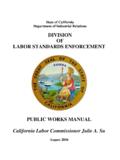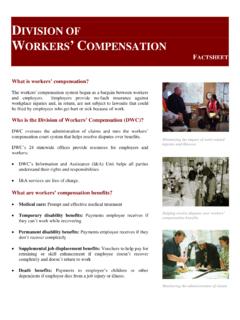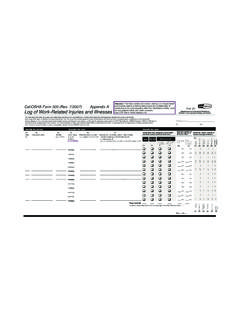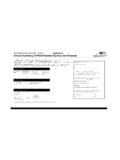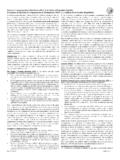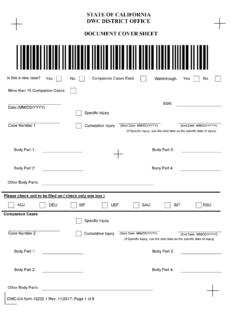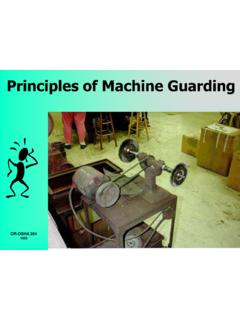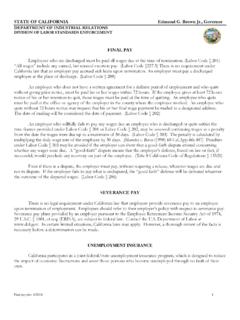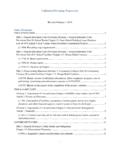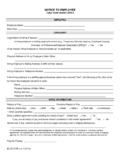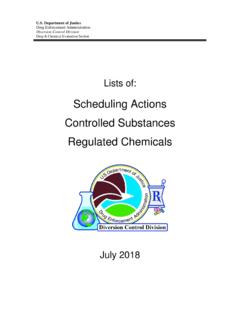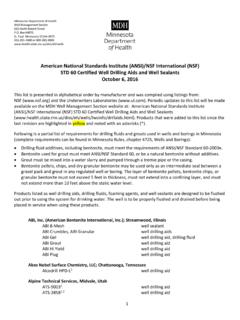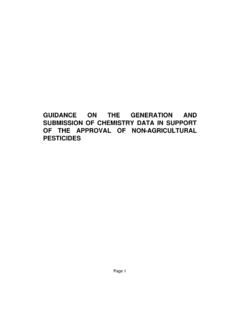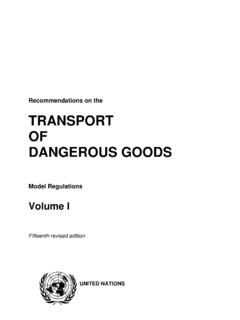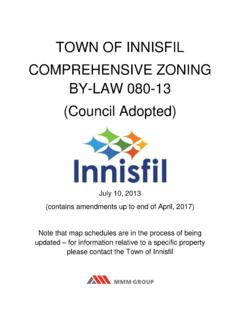Transcription of CAL OSHA POCKET GUIDE FOR THE …
1 CAL/OSHA. POCKET GUIDE FOR. THE construction . industry . Table of Contents About This POCKET GUIDE .. 1. Workplace Safety and Health .. 1. Access .. 2. Administrative Requirements .. 4. Aerial Devices and Elevating Work Platform .. 8. This GUIDE .. Airborne Contaminants and Dust .. 9. does not provide full legal interpretation of Cal/OSHA Air Compressors .. 10. regulations or their underlying statutes. Asbestos .. 10. Readers should refer directly to Cal/OSHA Title 8. regulations in the California Code of Regulations Blasting (Abrasives/Sand) .. 10. ( ). and to the California Labor Code ( Blasting (Explosives) .. 15. ) for detailed information regarding Carcinogens .. 17. the scope, specifications, and exceptions of a particular regulation and for other requirements that may be applicable Code of Safe Practices.
2 18. to their operations. Competent Person .. 18. Updated June 2015. Concrete construction .. 18. Produced by the California Department of Industrial Relations (DIR), Division of Occupational Safety and Health (Cal/OSHA), Confined Spaces .. 23. Consultation Services Branch Corrosive Liquids .. 25. To obtain copies of Cal/OSHA safety and health publications, Cranes .. 26. contact a Cal/OSHA Consultation Services office listed in the back of this booklet, or go to Demolition .. 34. Dust, Fumes, Mists, Vapors, and Gases .. 36. Electrical .. 37. Elevators, Lifts, and Hoists .. 40. Emergency Medical Services .. 41. Engine Exhaust Emission .. 42. Erection and construction .. 43. Ergonomics in construction .
3 46. Cal/OSHA POCKET GUIDE for the construction industry | June 2015 i Excavation, Trenches, and Earthwork .. 48 Ramps and Runways .. 107. Explosion Hazards .. 56 Roofing Operations .. 107. Fall Protection .. 57 Scaffolds .. 112. Fire Protection and Prevention .. 62 Silica Dust .. 126. Stairways .. 127. First Aid .. 63. Temporary Agencies .. 128. Flaggers .. 63. Toeboards .. 129. Flammable and Combustible Liquids .. 64. Toilets/Washing Facilities/Sanitation .. 130. Forklifts .. 65. Tools and Equipment .. 131. Forms, Falsework, and Vertical Shoring .. 67. Traffic Control .. 136. Guardrails .. 69. Training .. 137. Hazard Communication Program (HAZCOM) .. 71. Tunnels and Tunneling .. 139.
4 Heat Illness Prevention .. 73. Welding, Cutting, and Other Hot Work .. 141. Heavy construction Equipment .. 81 Wood Preservative Chemicals .. 144. Hot Pipes and Hot Surfaces .. 83 Work Over or Near Water .. 145. Housekeeping/Site Cleaning .. 84 List of Acronyms .. 146. Injury and Illness Prevention Program .. 84 Index .. 149. Ladders .. 87. Laser Equipment .. 92. Lead .. 93. Lighting .. 96. Lock-out/Block-out Procedures .. 97. Machine Guarding .. 100. Multi-employer Worksites .. 100. Personal Protective Equipment .. 101. Pile Driving .. 103. Pressurized Worksites .. 105. Qualified Person .. 106. ii Cal/OSHA POCKET GUIDE for the construction industry | June 2015 Cal/OSHA POCKET GUIDE for the construction industry | June 2015 iii About This POCKET GUIDE The construction industry involves many types of work activities covered by numerous regulations in Title 8 of the California Code of Regulations (T8 CCR).
5 T8 CCR contains detailed information on regulations and workplace safety programs including specifications and exceptions. construction employers may have requirements in the construction Safety Orders (CSOs), Electrical Safety Orders (ESOs), Tunnel Safety Orders (TSOs), Compressed Air Safety Orders (CASOs), and the General industry Safety Orders (GISOs). To assist the construction industry in working safely and complying with Title 8 regulations, the Cal/OSHA Consultation Program has prepared this POCKET GUIDE . This GUIDE is intended to be used as a reference for workers, employers, supervisors, job stewards, safety personnel, and others. This POCKET GUIDE : Summarizes safety requirements from T8 CCR that apply to the construction industry .
6 It is not meant to be either a substitute for or a legal interpretation of the occupational safety and health regulations in Title 8 of the California Code of Regulations (see T8 CCR for detailed information). Lists the major subject headings in alphabetical order in the Table of Contents and each subject heading is linked to its content. Provides highlights of selected safety standards in each major subject heading within its scope and may also include best practices in safety and health. Is not all inclusive. The contents under the bullets, lists, notes, and exceptions are highlights of regulatory requirements, best practices and other construction safety and health information. Readers should refer directly to T8.
7 CCR for complete information. Contains abbreviations as described in the List of Acronyms section. It is available in pdf format and can be printed online. Workplace Safety and Health Proactive safety and health programs are an effective way to prevent workplace injuries and illnesses and reduce the costs of doing business. In such programs employers and employees work together where safety and health is always a part of the Cal/OSHA POCKET GUIDE for the construction industry | June 2015 1. decisions made, and all employees and supervisors are fully C. Elevating work platforms, such as vertical towers and scissor trained to work safely. The benefits of effective, proactive safety lifts, are designed to raise and hold a work platform in a programs include: substantially vertical axis.
8 3637, 3642. Higher productivity and employee morale D. Industrial trucks, such as rough terrain forklifts, may be used to elevate and position workers under specific conditions. 3657. Higher quality of work and products produced E. Elevators ( construction ) are required as follows: Fewer worker injuries 1. For structures or buildings 60 ft. or more above ground Lower compensation insurance cost and absenteeism level or 48 ft. below ground level. 1630(a). Lower employee turnover 2. At demolition sites of seven or more stories or 72 ft. or more in height. 1735(r). A written Injury and Illness Prevention Program (IIP Program). should be the foundation for all of your other safety and health Note: Elevators must be inspected and tested in the programs and is required for every workplace regulated under presence of a DOSH representative before use.
9 A permit Title 8 of the California Code of Regulations (T8 CCR). A summary from DOSH is required to operate. (a). of the basic elements of an IIP Program has been included in F. Personnel hoists may be used at special construction sites, the Injury and Illness Prevention Program section of this GUIDE . such as bridges and dams, if approved by a registered Employers are also encouraged to use Cal/OSHA's IIP Programs engineer. (c). eTool ( ) to develop a specific IIP program tailored to their own workplaces. G. Ladders can be used to gain access to working surfaces above and below ground level under certain conditions. 1675. Remember, the effectiveness of all your safety programs depend H.
10 Ramps and runways provide means of access for foot or on how well you actually implement and maintain them. You must vehicle traffic. 1623, 1624, 1625. regularly review and update your programs in order to keep them effective. Employers and employees must also remember that the I. Stairways must be installed in buildings that have two or more regulations in T8 CCR only set minimum requirements and they stories or are 24 ft. or more in height. 1629(a)(1). should strive to exceed the standards at all times. 1. For buildings of two and three stories, at least one stairway For safety and health related assistance, employers and is required. 1629(a)(4). employees may contact the nearest Cal/OSHA Consultation 2.
